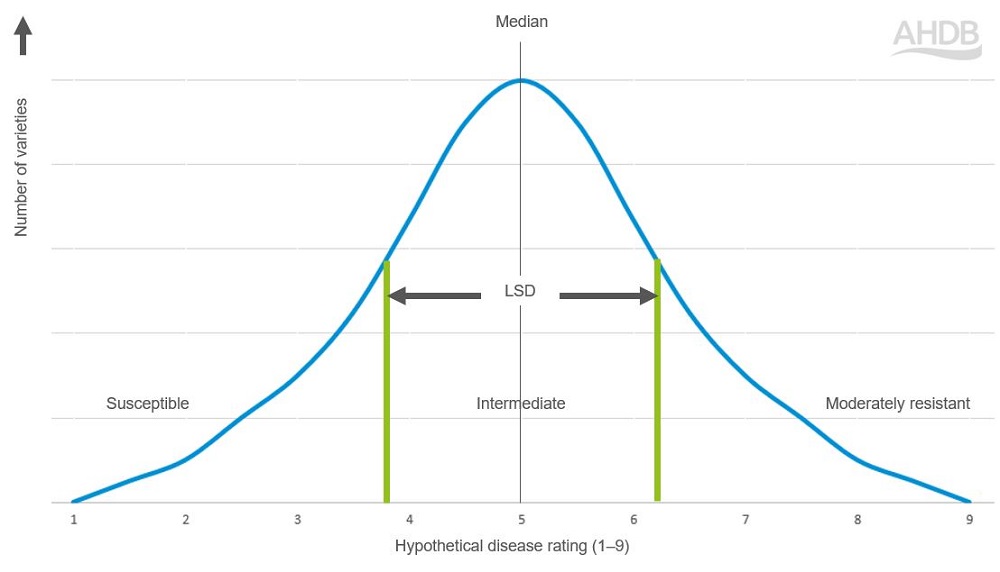Understanding the new verticillium stem stripe ratings in the Recommended Lists (RL)
Monday, 18 December 2023
The latest winter oilseed rape recommended list (2024/25) features information on verticillium stem stripe resistance for the first time. Paul Gosling, who leads the Recommended Lists (RL) project at AHDB, provides an overview of the ratings and explains why they have different categories to other diseases.
About verticillium
Caused by Verticillium longisporum, the disease was first confirmed in oilseed rape in England in 2007, with the established common name adopted – verticillium wilt. However, the disease was renamed verticillium stem stripe in oilseed rape in 2016, due to a lack of wilting symptoms (compared to horticultural brassicas).
The disease can cause severe yield losses (more than 30%), with the biggest losses associated with seed loss. In the run-up to harvest, high temperatures and drought stress exacerbate symptoms. Crops in eastern England are often the most severely affected, although symptoms have been reported much more widely.
Because it is soilborne and persistent, the disease builds when susceptible hosts are present. With no fungicide treatment available, the only effective control is to widen rotations. However, as the gap between susceptible crops may need to be more than a decade, tackling it effectively through rotations is often impractical.
Developing a disease rating
The better news is that it quickly became evident that there were differences in the susceptibility of varieties to the disease.
Over the past decade, AHDB has funded work to understand verticillium stem stripe and develop protocols to assess it in variety trials (with ADAS and NIAB playing important roles).
Average disease severity index data from varieties in the RL harvest 2023 trials is shown in the bar graph below.
It reveals the range of resistance, with varietal resistance increasing towards the right-hand side of the graph.
Verticillium disease data from RL trials (harvest 2023)
 AHDB
AHDB
However, the data is associated with a large least significant difference (LSD) value of 12.6, which is problematic.
Only differences between variety means that are larger than the LSD are statistically significant at the 5% level –meaning the result is only likely to occur by chance fewer than 1 in 20 times.
It is hard to pull apart varieties associated with such a large LSD.
Following conversations with our statistical partner BIOSS (Biomathematics and Statistics Scotland), it was decided we could not base the disease ratings based on the usual 1–9 scale. Instead, we mapped the 1–9 disease ratings to one of three disease-rating categories:
- Moderately resistant (MR)
- Intermediate (I)
- Susceptible (S)
The line graph below provides a simplified view of the data – in a bell-shaped curve (blue line) – to illustrate the rating process.
Mapping the three verticillium rating categories
 AHDB
AHDB
As part of the rating calculation, the middle of the LSD is centred in the middle of curve (on the median value).
The LSD range captures the intermedial (I) varieties and highlights the susceptible (S) and moderately resistant (MR) varieties at the extremes.
The S and MR categories are significantly different from each other (at the 5% level).
Ratings in practice
If you think your field is at risk from verticillium stem stripe, use the winter oilseed rape recommended list to identify moderately resistant varieties and avoid the susceptible varieties.
Although data is currently limited for most varieties, data set robustness is likely to improve with successive editions of the RL.
Further information
This article is based on a presentation delivered by Paul Gosling at the 2023 Agronomy Conference on 7 December 2023.
Watch the RL trial presentation at the Agronomy Conference
Learn more about the RL verticillium disease assessments
Read about the symptoms and management of verticillium stem stripe

Topics:
Sectors:
Tags:


